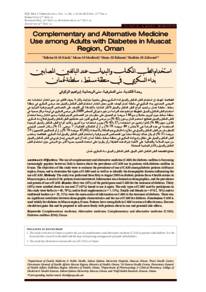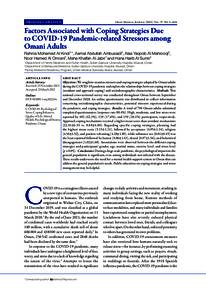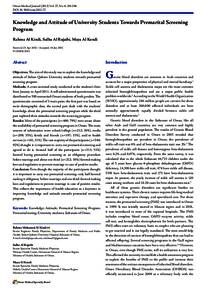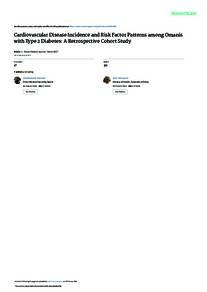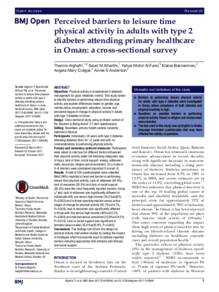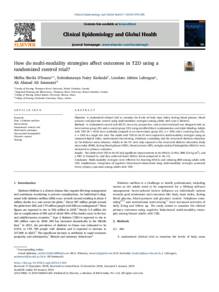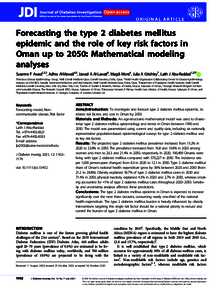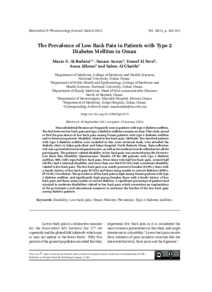Document
Complementary and alternative medicine use among adults with diabetes in Muscat Region, Oman.
Contributors
Other titles
استخدام الطب المكمل والبديل عند البالغين المصابين بداء السكري في منطقة مسقط، سلطنة عمان
Publisher
College of Medicine, Sultan Qaboos University.
Gregorian
2011-02
Language
English
English abstract
Objectives: The use of complementary and alternative medicine (CAM) for diabetes mellitus is becoming
increasingly popular; however, little is known about the prevalence of CAM use in patients with diabetes mellitus in
Oman. The objectives of this study were to estimate the prevalence of use of CAM among diabetic patients in Muscat
region, Oman, and to determine the types of CAM used as well as to identify the demographic features influencing the
use of CAM. Methods: The study was performed from May to August 2009 on diabetic patients from 4 health centres in
Muscat region. A total of 146 patients were interviewed. Information was obtained on demographics, and the prevalence
and pattern of use of CAM. Results: Sixty two (42%) of the participants used CAM for the treatment of diabetes. Thirty
(48%) were satisfied about its use and 27 (43%) intend to use it again. The only types of CAM used by participants in
this study were herbs (n = 49, 79%), and/or food supplements (n = 7, 11%). Family and friends (n = 47/62, 76%) and/or
traditional healers (n = 19, 31%) were the main source of information on CAM in the treatment of diabetes. There was
no significant correlation between demographic characteristics and the use of CAM for diabetes. Conclusion: CAM is
used widely for diabetes in Muscat region, Oman. Patients have strong faith in CAM in terms of effectiveness. Doctors
should recognise this and be prepared to talk more freely with patients about its use and potential side effects.
Member of
Resource URL
Citation
Al-Kindiyah, Rahma M., Al-Mushrafiyah, Muna, Al-Rabaaniyah, Muna, & Al-Zakwani, Ibrahim (2011). Complementary and Alternative Medicine Use among Adults with Diabetes in Muscat Region, Oman. Sultan Qaboos University Medical Journal, 11(1), 62–68.
Arabic abstract
الهدف: إن استخدام الطب المكمل والبديل لداء السكري يحظى بشعبية متزايدة، ولكن لا يعرف الكثير عن مدى انتشار استخدامه عند المرضى المصابين بداء السكري في سلطنة عمان. الهدف: تقدير معدل انتشار استخدام الطب المكمل والبديل عند مرضى السكري في منطقة مسقط ، سلطنة عمان، وتحديد أنواع الطب المكمل والبديل الأكثر انتشارا، بالإضافة إلى التعرف على الخصائص الديموغرافية المؤثرة في استخدام الطب المكمل والبديل. الطريقة: تم تنفيذ هذه الدراسة من شهر مايو إلى أغسطس 2009 على مرضى السكري في أربعة مراكز صحية في منطقة مسقط، حيث أجريت مقابلات مع 146 مريضا. تم الحصول على معلومات عن الخصائص الديموغرافية، ومدى انتشار ونمط استخدام الطب المكمل والبديل. النتائج: استخدم اثنان وستون (42 %) من مرضى السكري الذين تمت مقابلتهم الطب المكمل والبديل لعلاج داء السكري ثلاثون منهم (48 %) كانوا راضين عن استخدامه و27 (43 %) ينوون استخدامه مرة أخرى. وكانت أنواع الطب المكمل والبديل الوحيدة المستخدمة في هذه الدراسة هي الأعشاب ( 49 مريضا، 79 %)، و / أو المكملات الغذائية ( 7 مرضى، 11 %). وكان المصدر الرئيسي للمعلومات عن الطب المكمل والبديل في علاج داء السكري هم العائلة والأصدقاء (47/62 مريضا، 76 %) و / أو المعالجين الشعبيين ( 19 مريضا، 31 %) لم يكن هناك ارتباطا معتدا بين الخصائص الديموغرافية واستخدام الطب المكمل والبديل لداء السكري. الخلاصة: يستخدم الطب المكمل والبديل على نطاق واسع لداء السكري في منطقة مسقط، سلطنة عمان، كما أن لدى المرضى إيمان قوي في الطب المكمل والبديل من حيث السلامة والفعالية. على الأطباء إدراك هذه الحقيقة وأن يكونوا على استعداد للحديث بحرية أكبر مع المرضى حول استخدام الطب
المكمل والبديل والآثار الجانبية المحتملة
المكمل والبديل والآثار الجانبية المحتملة
Category
Journal articles

